Description
Introduction
Cloudera for Business Intelligence(BI) is a critical component for making informed decisions. Cloudera’s integration of Apache Hive and Impala offers powerful tools for querying and analyzing big data stored in Hadoop-based ecosystems. This course is designed to help you understand how to leverage Hive and Impala to perform fast, interactive SQL-based analytics on big data, enabling actionable insights. You will learn how to optimize queries, manage data structures, and integrate with BI tools to empower your data analytics workflows.
Prerequisites
- Basic understanding of SQL and relational database concepts.
- Familiarity with Hadoop and distributed data processing concepts.
- Some experience with data analytics or BI tools (e.g., Tableau, Power BI) is recommended.
- Basic knowledge of Cloudera platform components.
Table of Contents
- Introduction to Cloudera for Business Intelligence
1.1 What is Business Intelligence?
1.2 Overview of Cloudera’s Data Analytics Capabilities
1.3 Key Features of Hive and Impala for BI - Setting Up the Environment
2.1 Installing and Configuring Cloudera for Hive and Impala
2.2 Data Integration with Hadoop Ecosystems
2.3 Accessing Cloudera Manager and Navigator for BI Workflows - Introduction to Apache Hive
3.1 Overview of Hive Architecture and Components
3.2 Creating and Managing Hive Tables
3.3 Understanding HiveQL: Basics and Syntax
3.4 Data Partitioning and Bucketing for Performance - Introduction to Apache Impala
4.1 Overview of Impala Architecture(Ref: Cloudera Security: Data Protection, Privacy, and Access Control)
4.2 Key Differences Between Hive and Impala
4.3 Setting Up Impala for High-Performance Queries
4.4 Using Impala Shell and SQL for Analytics - Querying Big Data with Hive and Impala
5.1 Writing SQL Queries for Hive and Impala
5.2 Handling Complex Data Types and Joins
5.3 Using UDFs (User Defined Functions) for Advanced Analysis
5.4 Query Optimization Techniques for Large Datasets - Performance Optimization for BI Queries
6.1 Tuning Hive for Better Query Performance
6.2 Using Caching and Impala’s In-Memory Capabilities
6.3 Parallel Query Execution and Load Balancing
6.4 Indexing and Compression for Faster Queries - Data Visualization and Reporting
7.1 Integrating Hive and Impala with BI Tools (Tableau, Power BI, etc.)
7.2 Creating Dashboards and Visualizations from Query Results
7.3 Automating BI Reports with Scheduled Queries - Data Security and Governance in BI Workflows
8.1 Managing Access Control and User Permissions
8.2 Data Masking and Encryption in Hive and Impala
8.3 Auditing and Monitoring Query Activities(Ref: Building Data Pipelines with Cloudera: Automation and Efficiency)
8.4 Ensuring Compliance with Data Governance Policies - Advanced Analytics with Hive and Impala
9.1 Analyzing Structured and Semi-Structured Data
9.2 Using Window Functions and Analytics Functions
9.3 Real-Time BI with Impala for Streamed Data
9.4 Conducting Predictive Analytics with Hive Integration - Big Data Warehousing with Hive and Impala
10.1 Building Scalable Data Warehouses on Hadoop
10.2 Managing Metadata with Hive Metastore
10.3 Best Practices for ETL Processes in Hive
10.4 Creating Aggregated Data Models for BI - Troubleshooting and Best Practices
11.1 Common Query Issues and Solutions
11.2 Debugging Hive and Impala Workflows
11.3 Monitoring and Logging BI Workflows in Cloudera
11.4 Best Practices for Scalable BI Deployments - Case Studies and Real-World Applications
12.1 Retail Analytics: Optimizing Sales and Inventory
12.2 Financial Analytics: Risk Assessment and Fraud Detection
12.3 Healthcare Analytics: Improving Patient Outcomes
12.4 Manufacturing Analytics: Enhancing Operational Efficiency - Preparing for Cloudera BI Certification and Beyond
13.1 Cloudera Data Analyst Certification Overview
13.2 Practice Resources and Study Guides
13.3 Advancing Your Career in Business Intelligence with Cloudera
Conclusion
By completing this course, you will gain the skills and knowledge to harness the power of Apache Hive and Impala for business intelligence and big data analytics. You’ll be able to efficiently query and analyze large datasets, integrate results with visualization tools, and deliver actionable insights to drive business decisions. With these capabilities, you’ll become proficient in building scalable and optimized BI workflows using the Cloudera platform.







Reviews
There are no reviews yet.